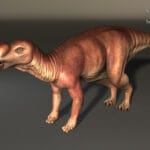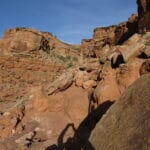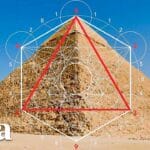Journey back to the Late Cretaceous period and encounter the awe-inspiring Diabloceratops eatoni, a unique ceratopsian dinosaur that roamed what is now Utah approximately 81 million years ago. With a face that could rival a heavy metal album cover, this intriguing herbivore sported a short snout, menacing horns, and a frilled collar adorned with spikes and knobs. Unlike its more famous relative, *Triceratops*, *Diabloceratops* represents a more primitive branch of the horned dinosaur family, offering valuable insights into ceratopsian evolution.
Decoding Diabloceratops: An Evolutionary Enigma
Imagine a world vastly different from our own, where North America is divided by a shallow sea, and Diabloceratops inhabits the western landmass known as Laramidia. This herbivore shared its world with fearsome predators, likely using its horns and frill for defense and display rather than hunting. The horns, perhaps brightly colored, may have served as a warning to rivals or a shield against predators like tyrannosaurs.
Diabloceratops holds a unique position in the ceratopsian lineage, showcasing a blend of ancestral and derived traits. Its skull, a mosaic of old and new, features outward-curving brow horns, a prominent nasal horn, and a relatively short, spiked frill. This unusual combination suggests Diabloceratops represents a transitional stage in ceratopsian evolution, connecting earlier forms to later, more well-known species like Triceratops and Styracosaurus. Its discovery adds another layer of complexity to the centrosaurine family tree, highlighting the intricate branching of evolutionary pathways.
Ongoing research seeks to unravel the mysteries surrounding Diabloceratops. Scientists continue to debate the precise function of the frill, exploring possibilities ranging from display and defense to thermoregulation. Clarifying its relationships with other ceratopsians also remains an active area of study, as new fossil discoveries and analyses may further refine our understanding of its place within the ceratopsian family.
Why “Devil-Horned Face”? Unraveling the Name
The name Diabloceratops immediately conjures an image of a fearsome beast. The moniker, meaning “devil-horned face,” perfectly captures its unique and somewhat intimidating appearance. Let’s break down the etymology: “Diablo,” Spanish for “devil,” refers to the prominent, curved horns that extend outwards and forwards from the brow, while “ceratops,” derived from Greek and Latin roots, translates to “horned face,” a common descriptor for ceratopsian dinosaurs.
The full species name, Diabloceratops eatoni, honors paleontologist Jeffrey Eaton of Weber State University, a friend of the lead author, Jim Kirkland who described the species in 2010. Discovered in 1998 and excavated in 2000 in Utah’s Wahweap Formation, Diabloceratops eatoni provides a unique window into the diverse world of Late Cretaceous ceratopsians. While the name suggests a menacing predator, Diabloceratops was, in fact, a herbivore, adding a layer of irony to its moniker and underscoring the importance of scientific naming conventions.
Diabloceratops Diet: Unlocking the Secrets of this Horned Herbivore
Despite its fearsome name, Diabloceratops, like all ceratopsians, was a herbivore, thriving on the abundant plant life of the Late Cretaceous period. Its diet likely consisted of ferns, conifers, and angiosperms, the dominant flora of the time. The beak-like mouth, a hallmark of ceratopsians, efficiently clipped leaves and stems, while rows of specialized teeth behind the beak ground the tough plant material, extracting essential nutrients.
One intriguing feature is Diabloceratops‘ lack of a prominent nose horn, unlike many other ceratopsians. This absence raises questions about its feeding strategies and how it may have differed from its relatives. Some scientists suggest this lack of a nose horn may have allowed for more efficient grazing closer to the ground or access to different types of plants.
| Feature | Description | How it Helped with Eating |
|---|---|---|
| Beak-like mouth | Similar to a parrot’s beak | Snipping leaves and stems |
| Teeth | Rows of specialized teeth behind the beak | Grinding tough plant material |
| No Large Nose Horn | Unlike other ceratopsians, Diabloceratops lacked a prominent nose horn. | Potentially more efficient grazing behaviors |
| Large Size | A substantial body, needing lots of fuel. | Able to eat large quantities of plant material |
Our understanding of dinosaur diets continually evolves with new research. While we can deduce much from fossil evidence, uncertainties remain. What specific plant species did Diabloceratops favor? How did it compete with other herbivores for resources? Further research may shed more light on these intriguing questions.
Diabloceratops Size Comparison: How Did This Horned Dinosaur Measure Up?
Diabloceratops was a medium-sized ceratopsian, reaching lengths of up to 4.5 meters (15 feet) and weighing an estimated 1.3 metric tons (1.4 short tons). While impressive, this pales in comparison to its more famous relative, Triceratops, which could exceed 9 meters in length. Think of Diabloceratops as roughly the size of a mid-size moving truck, packed with the weight of a small car. Though not a giant among dinosaurs, it was certainly a substantial creature.
Fossil evidence suggests Diabloceratops was a robust animal, likely capable of defending itself against predators with its horns and bulky build. Its size, combined with its distinctive horns and frill, would have made it a formidable presence in the Late Cretaceous landscape.
| Feature | Estimated Size | Comparison |
|---|---|---|
| Length | 4.5 meters (15 feet) | Length of a mid-size moving truck |
| Weight | 1.3 metric tons (1.4 short tons) | Weight of a small car |
| Size Class | Medium | Compared to other ceratopsians |
Current size estimates are based on available fossil finds. As paleontological research continues, new discoveries could refine our understanding. Variations in size within the species, based on factors like age, sex, and individual differences, are also probable. The study of Diabloceratops‘ size, alongside its other characteristics, provides a valuable glimpse into the diversity and evolutionary history of ceratopsian dinosaurs.
Learn more about the fascinating ear of Dionysius and its astonishing acoustics or discover the incredible ancient predator, the Edestus, and its unique adaptations.
- Georgia Platform: A Southern Strategy, 1850s - March 31, 2025
- How many weeks is 40 days: Quick Conversion Guide for Accurate Results - March 31, 2025
- How many feet is 300 meters? 984 Feet: Understand Length Conversions Easily - March 31, 2025
















1 thought on “Diabloceratops: Unearthing the Devil-Horned Dinosaur of Utah”
Comments are closed.